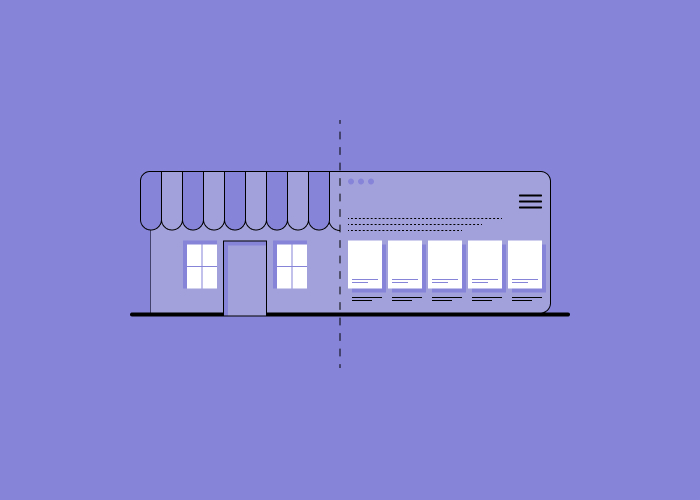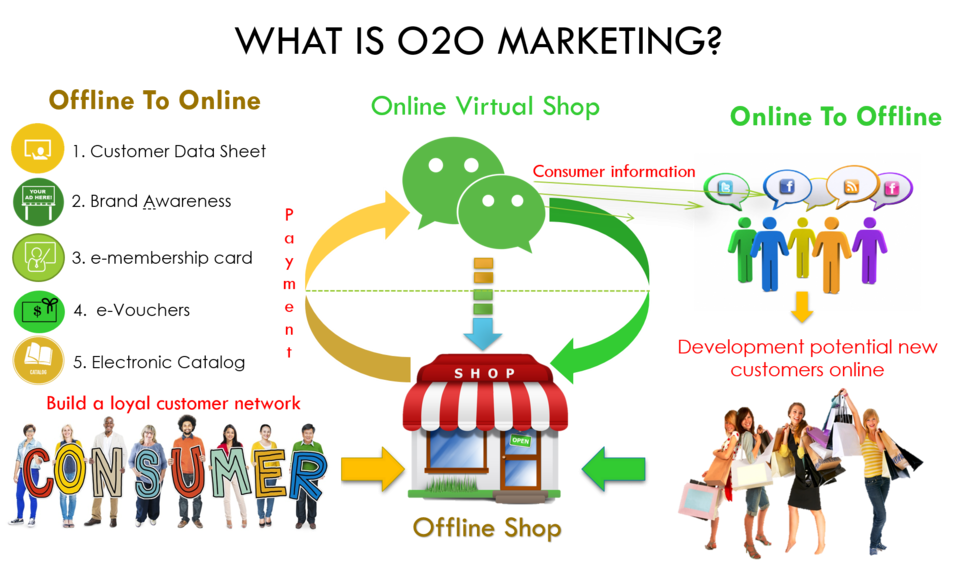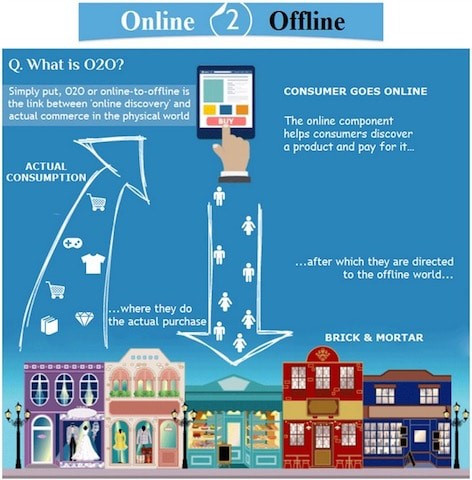Content
How Does Online to Offline Business Work?

In the age of information, many expect that virtual reality will replace the traditional commerce in the near future. However, it is becoming apparent that as a result of the “mobile revolution”, we did not switch to virtual reality, but began to rapidly develop online-to-offline commerce.
What Is O2O?
The future of online sales is outside the Global Network. In other words, it is offline. O2O methods include receiving goods purchased over the Internet in a store, returning goods purchased over the Internet to a physical store, and the ability to place orders online while being in a physical store.

Image Source: clarity.fm
Meanwhile, Amazon is presenting a same-day delivery system, which is going to change the consumers’ opinion about shopping once and for all. The secret of the revolutionary online-offline system is simple - the sales giant bought Whole Foods Markets in 2017 and intends to place its own warehouse with service staff all over the USA.
Lets talk about itHave a project in mind?
Along with this, co-founder of the Warby Parker eyewear manufacturing and selling company, Dave Gilboa, found that although only 10% of their products are sold offline, these sales help to keep customers and ensure the company's commercial success on the Internet.
In general, the O2O model has not completely destroyed all other types of sales; instead, the Internet has become a harmonious part of the everyday shopping process.
About 70% of buyers research online before they buy the product in an offline store, and almost every fourth visitor to a regular store checks the information about the product online via smartphone without leaving the store.
So how should e-commerce startups meet the coming future? How to adapt to it with the lowest loss?
Read also: How to Write an eCommerce Business Plan
E-Marketing and Offline Stores
First of all, let’s clarify it: e-commerce is not going to disappear at all. If the traditional retail is more convenient for the buyer because of instant satisfaction from the purchase, online retailers offer consumers a level of variety and novelty of products that is simply unattainable without the Internet.
Despite the benefits we have mentioned, it is becoming increasingly difficult to do e-commerce, partly because of the number of competitors.
In 2012, 30% of visitors went to Amazon to explore the most popular products, and 13% satisfied their curiosity through a Google search. How to reach potential buyers who are not involved in the marketing process?
The answer is to combine online to offline and offline to online methods.
Suppose you have a regular souvenir shop. Of course, before going online, you start building a client base with a list of existing offline clients. Anyway, you can no longer be competitive without using e-marketing.
An example: Justin Winter built his eCommerce business with an annual turnover of $12,000,000 in just 18 months. His company Diamond Candles sells decorative scented candles for the home, and yes, there is a ring inside each candle, and maybe even a diamond (the price of a candle ranges between $10 and $5,000).
The secret of Justin's success is that he posted 7 links to his online store on popular eCommerce sites.
Going Offline, Start with Profit
The title of this part is likely to amuse some readers. Of course, we all want to make a profit. But at the moment we are talking with full seriousness: the switch to offline commerce is a significant step. This means that you have to pay the cashiers, pay for rent and utilities, maintenance and security, and much more.
If the prospect of regular payments seems frightening, remember that the first "showroom" of the now prosperous Warby Parker company was located in the dining room of one of the company’s co-founders.
Will you follow the founders of Warby Parker, setting up a showroom at your house? Will you put up a kiosk on the forecourt or trade from your van? We suggest starting by reaching the minimum viable level of the store. This experience will give you an idea of your potential offline income and what you should do to increase profits.
In other words, find a way to make a profit in the “real world” before negotiating with your first investor or for a loan to a bank.
It is necessary to understand how offline commerce differs from its digital version and to learn some practical lessons before opening a full-fledged retail store.
Conversion Optimization for the Online-Offline Retailer
When we say that the future of online marketing is offline, that's exactly what we mean: you are still engaged in eCommerce, and this means that you must use CRO (conversion rate optimization) to successfully sell goods in the physical store.
To maximize sales and customer retention on both commerce platforms, you should optimize both your website/landing pages and your offline store.
O2O Business Model
We believe that you already know how to optimize selling landing pages and an eCommerce site as a whole, increase the email subscription base and carry out an advertising campaign on social networks. All these skills will come in handy for optimizing offline sales. The first thing you need is to determine how much you would divide your online and offline commerce. Here are the reasons why this should be done:
- Most visitors of your site don't live in the area where your offline store is located. Calls to action focused on your physical store will create confusion, creating the impression that your visitors will not be able to buy your product online.
- Your online store’s warehouse may be missing items listed on the website. If you accidentally create the impression that visitors can buy all these products in your regular store, you may disappoint them. This can be very damaging to your business.

Image Source: medium.com
Google takes into account the factors of geolocation in its search algorithm, so the site localized for a particular geographical point will specify the goods available in the local store. Thus, visitors are sure they find the product they need in the offline store and are satisfied with the result of the search query, therefore with the work of the company as a whole.
When separating the online and offline areas of your business, pay attention to the following CRO cases:
- Your call to action is no longer a bright button - now it is a phone number or a map to the store. Use familiar tricks to highlight it: placing the call in the foreground, in the center of the landing, with arrows pointing at it, etc.
- You have to deal with the following tasks: convince the visitor that they need to get into a car and come to your store to see the product. Don’t make a mistake thinking that the close physical location of your product and store means that you only need to briefly describe the offer to convince the potential buyer. On the contrary, it is likely to cause suspicion: “Such a small description! They must be hiding something! ”
- Don't hide anything. Consumers want to see prices and product details. Give them even more information than they could expect. If you are worried that the price will scare them away, then keep in mind that most buyers will not even consider buying without first finding out the price.
- Although there is no such thing as full A/B testing for offline sales, you can use split testing for landing pages with coupons. Tracking coupon codes from specific landing pages, you can see which landing pages are visited most often by “coupon collectors”. Sure, such a sample is not truly representative, but still, it is good enough to compare the converting effectiveness of the design of landing pages/sites.
Online to Offline in Covid-19 Times
Finally, we need to address the elephant in the room. Covid-19 really wreaked havoc on offline businesses, making many smaller entrepreneurs file for bankruptcy. As the situation stays unstable and, by the most optimistic predictions, the world is going to carry on this way at least until late 2020, having your business represented online is not just a wise decision, but a necessary one if you want to stay afloat.
However, there is another side to this. The number of purchases made online has grown very significantly, and you have to be ready to employ and manage a small army of delivery persons to make sure your customers get their orders on time. That's why having an offline pickup point or two (or more if your budget allows it) would help you lessen the load on your employees, and keep your clients satisfied.
Conclusion
Although eCommerce has entered our lives, the most successful and far-sighted industry representatives are diversifying their efforts and going deeper into the “physical world” in order to increase sales both online and offline.
E-commerce startups don’t have to take this step right now, but they should think about how they will adapt to the inevitable changes from the very beginning.
If you are not sure how to integrate the smooth transition to offline business in your e-commerce store, we are always there for you. Our experience in working with e-commerce websites based on Magento, Shopware or custom solutions allows us to take on projects of any difficulty. Just reach out, and we’ll do our best to help you transition to the O2O model smoothly.
Let professionals meet your challenge
Our certified specialists will find the most optimal solution for your business.

